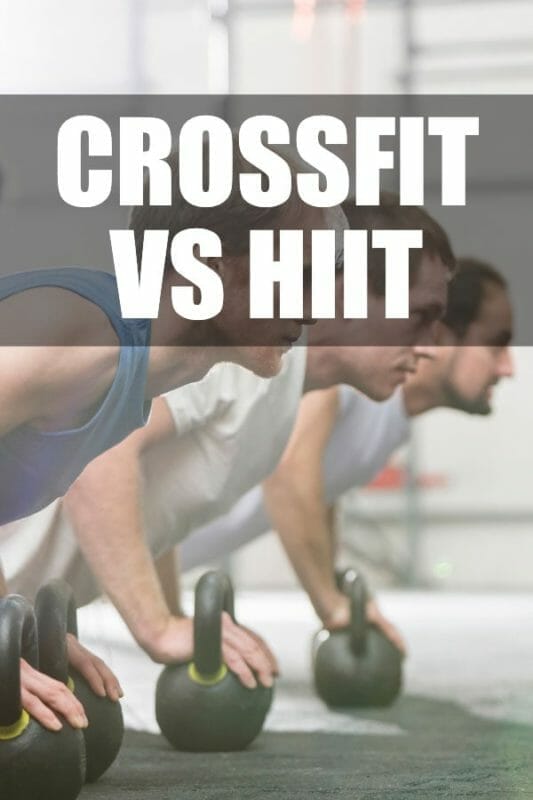You've heard the hype about both HIIT (
Remember that one training method is not necessarily better than the other. They both serve multiple purposes and have been successful at improving the fitness levels of millions of people.
The CrossFit and HIIT protocols have many similarities that are worth examining. There are claims that CrossFit is based on HIIT, a workout protocol developed in the 70s (CrossFit is a younger sport) and it's easy to see why. But there are enough differences to keep proponents of each training regime in their respective camps.
HIIT: What is it and what does it involve?
HIIT is one of the most popular forms of interval training. It involves bursts of intense exercise that increase the heart rate to around 90% of heart rate maximum, followed by longer periods of low-intensity exercise which help bring the heart rate down and engage the anaerobic energy system.
The history of interval training goes all the way back to the early 1900s (or even before that) but HIIT in its present form developed in the 1970s.
The goal of HIIT is to improve your aerobic and anaerobic fitness, two of the components of a complete fitness regime. The other components (depending on who you ask) include power, flexibility, coordination and balance.
Typical HIIT workout
HIIT workouts always involve interval exercises.
HITT workouts might involve nothing more than a treadmill. A sample HIT workout might involve 45 seconds of jump squats, burpees, mountain climbers, flutter kicks, planks, Russian twists and lateral lunges with a 30-second rest in between each. Repeated for 30 minutes.
It’s easy to see that this type of
CrossFit uses Olympic weight lifting exercises and gymnastics as part of the class. The WOD (Workout Of the Day) is the part that’s most similar to HIIT or interval training workout. The WOD can also include Olympic weightlifting techniques and gymnastics, which are not as common in HIIT.
Who can do HIIT?
Absolute beginners to fitness might want to start off with some regular running, swimming, or biking to build up a level of tolerance to training. Intensive training can be a shock to the system. And the goal is not only to achieve a good level of fitness but to continue training on a long-term basis.
HIIT is also known by other names:
HIIE –
SIT – Sprint Interval Training
Regardless of the name, each training uses the same convention of short intense workouts. Interval training of this type has significant benefits for athletes wanting to improve their Vo2 Max.
How many times a week?
In contrast with medium-intensity style training, HIIT training gives the best return on investment when you take at least 24 hours off between workouts. 48 hours will give you even more time to recover. Take your age and physical conditioning into considering.
Older and less fit people (or those that work at higher intensity) need longer recovery times. Don’t train twice a day or within the 24-hour period. That might lead to over-training and fatigue.
It’s not bad to do HIIT every day but make sure you pay close attention to your energy levels, sleep, and nutrition.
CROSSFIT: What is it and what does it involve?
The goal of CrossFit is improving fitness.
That’s the official line from CrossFit HQ. Greg Glassman, an ex-gymnast started the fitness regime in the early 2000s. CrossFit involves plyometrics, Olympic weightlifting, gymnastics, callisthenics, and mobility training. It’s a sport ideally suited to
Whereas typically, HIIT workouts last less than 40 minutes and can be as short as 4 minutes. The CrossFit WOD can be anywhere from 6 to 60 minutes, but they are usually under 20 minutes.
A study from 2018 found that there were no health benefits for overweight adults using the HIIT protocol compared to moderate-intensity exercise.
The study mentioned that adherence to the HIIT regime was low. This probably affected the results.

Typical CrossFit Workout
Remember that CrossFit classes begin with a strength or gymnastic component. The larger the workload in the first part of the class, the smaller the workload in the WOD (these are rough rules – every gym is different). Total gym time is 1 hour.
There is also a stretching and mobility component which typically takes place at the start and end of class.
CrossFit workouts tend to focus on one or two movements through the entire time. An example is
Grace ends when you complete 30 reps of one exercise. However, it’s not as easy as it sounds. The Rx (prescription) weight is 135 lb (60 kg) for men and 95 lb (45 kg) for women. Try that for 30 reps.
Here's another CrossFit sample workout:
- 2 legless rope climbs, 15-ft. Rope
- 20 air squats
- Repeat for 5 rounds.
Short CrossFit workouts (WODs) are more common because of the 1 hour time limit.
Who can do CrossFit?
Anyone with a drive to improve their fitness can do CrossFit. Workouts always have a scaled option (meaning there's an easier option for beginners or less advanced athletes) so any level of fitness is acceptable.
Many of the Olympic lifting and gymnastic elements require a good level of flexibility and strength. Older populations, very young people, or anyone with an injury or disability should make small and gradual steps before attempting the more complex movements.
Compare CrossFit with F45 – another HIIT-style workout modality.
Which is better for weight loss?
Both types of exercise protocol will help you lose weight. The HIIT protocol is more focused on weight loss than CrossFit. If “fat reduction” is your primary goal, HIIT is a better choice.
How CrossFit and HIIT are similar
- Removing boredom from workouts is important in both protocols. CrossFit’s mantra of “constantly varied” is also present in HIIT. Workouts change daily and participants must learn to adapt. This helps improve general fitness levels.
- To get the most benefit, participants should follow a coach or trainer in both regimes.
- Both types of workout require a level of dedication and motivation that the ordinary gym-goer might not have or care to possess. The ease of regular self-administered workouts is tempting for people that look for the easy option.
- Both CrossFit and HIIT are for people that want to achieve something. Whether that be overall fitness, better muscle tone, improvements in strength, or otherwise, just turning up and going through the motions will not cut it at a CrossFit or HIIT workout.
How CrossFit and HIIT are different
- CrossFit introduces a more competitive edge to training. Many athletes take part in the CrossFit Open and the CrossFit Games every year. Even in daily classes, trainers post scores on the in-house boards. There is always an aspect of not only
self-comparison, but comparison with your peers. - HIIT focusses more on timed intervals of intensity followed by short rests. CrossFit workouts follow a set timeframe or a specific set of reps. Rest frequency is up to the individual to decide.
- CrossFit sets workout goals such as the number of reps to complete in a set timeframe. When the workout has a weight lifting component (a common feature of CrossFit training), the potential for injury is ever-present, especially among the more competitive types in the class.
- HIIT focusses more on “burning calories” than CrossFit. As a weight loss and body composition workout, HIIT is more suitable for overweight and out of shape individuals. CrossFit workouts are not designed to maximise weight loss. Body composition is also not a priority. Athletes who perform weight-lifting workouts, mobility exercises and WODs every day tend to develop exceptional bodies and maintain their ideal weight. But the focus is on strength and fitness rather than weight loss and body composition.
Why do HIIT or CrossFit and not regular weight training and endurance training?
One of the most important aspects of interval training is what’s sometimes called the Afterburn. Afterburn refers to the calorie-burning effect of interval training long after the workout has ended. The fat-burning component of regular low-mid intensity endurance training ends once the sessions finish.
The Afterburn effect is when your body continues to burn calories after working out thanks to Excess Post-exercise Oxygen Consumption (EPOC).
A study published in the Journal of Obesity discussed how “effect of regular aerobic exercise on body fat is negligible” and how other forms of exercise, such as interval training, were more effective for changing body composition.
Although the results of the tests were inconclusive, the study found that HIIT-type protocols appeal to most individuals interested in
A study from 2017 found that HIIT training (which would also include CrossFit-style workouts) has a higher impact on energy expenditure and EPOC than moderate-intensity workouts.
Fitness Primer: The Difference between Aerobic and Anaerobic Fitness
Aerobic fitness is measured using the VO2 Max scale (how much oxygen your body can take in and use) and is associated with stamina or endurance. Running and swimming at low to medium intensities are aerobic exercises.
Anaerobic fitness refers to the non-endurance sports that promote strength and power. Weightlifting typically fits into this category.

Really nice article; nicely articulated and explained.
Thanks Kelsey,
Glad you liked it.
really nice article, very well written and articulated
Thanks for the article. Very well explained.
This article was super helpful in explaining the differences between CF and HIIT. I was a little confused on the part under “why choose crossfit” where you state “A study from 2018 found that there were no health benefits for overweight adults using the HIIT protocol…”. Did you mean to say CrossFit, or did you stuck more info on HIIT in that section as well?
Hi Kelly,
That study found HIIT (which kind of includes CrossFit) does not have any specific benefits for overweight adults. The benefits come once the participant has reached a more optimal weight.
Hi
I want to know how to do Hiit and CrossFit